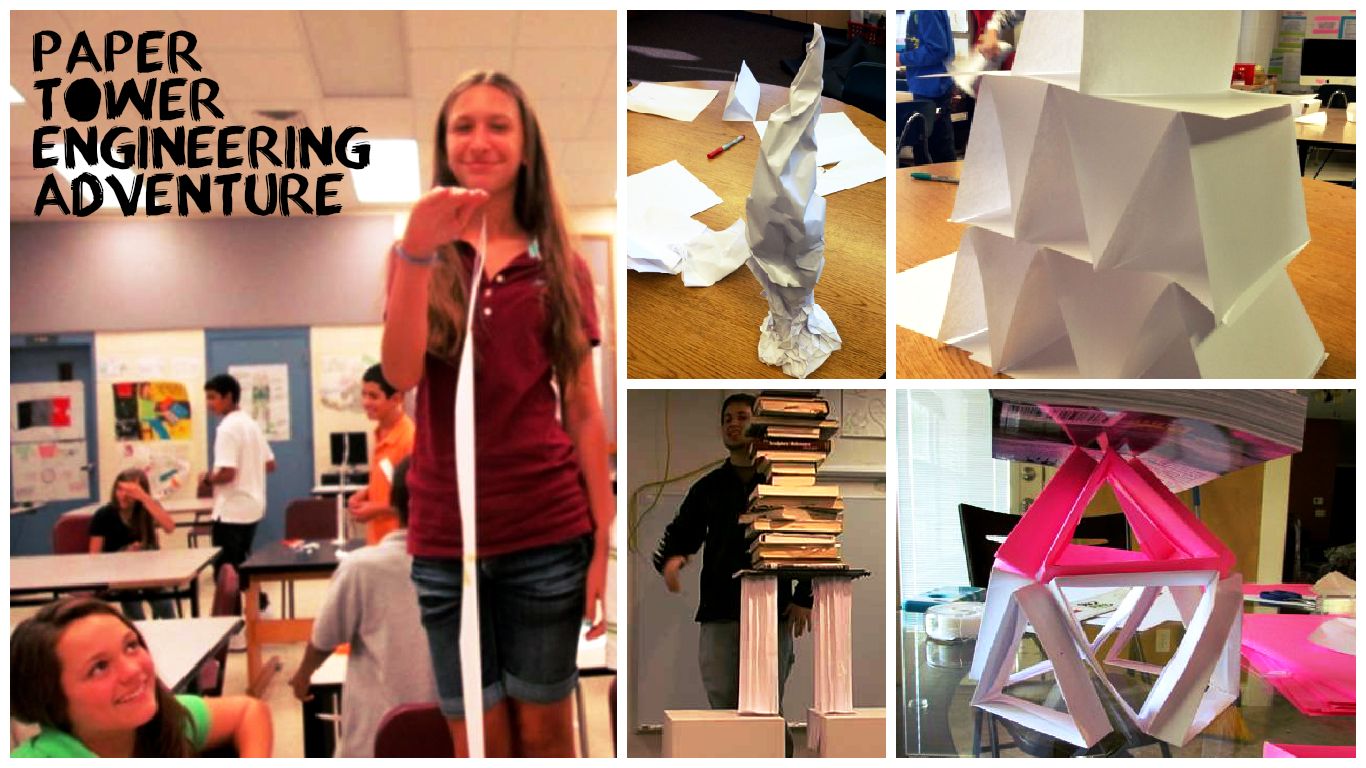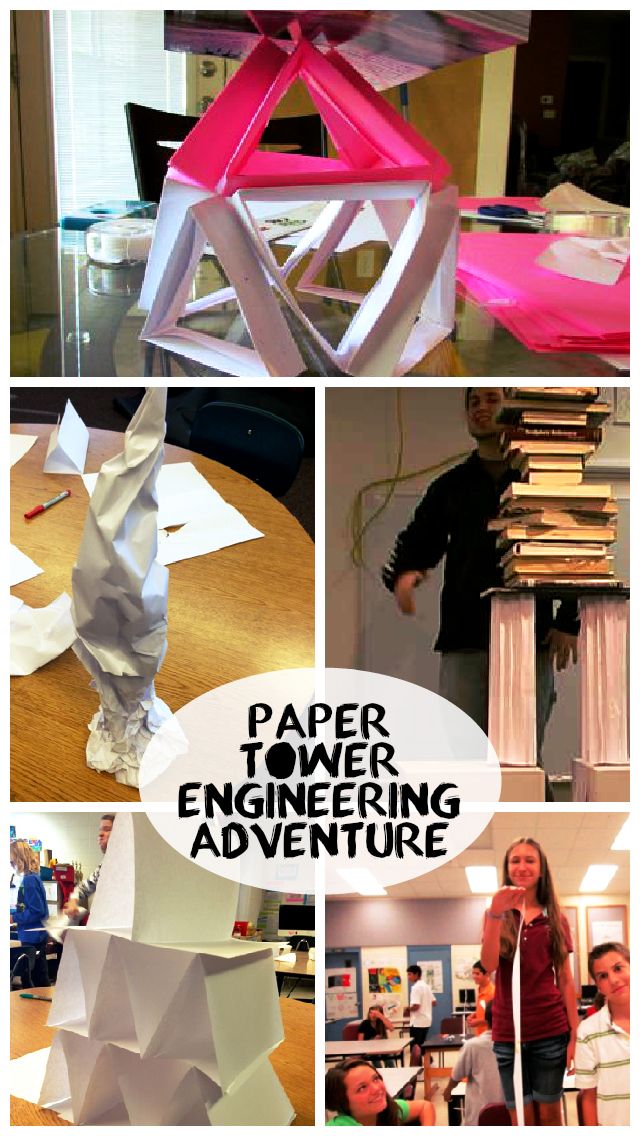
Above, left: two students from the class of teacher and blogger Mr. Goldstein show off their tallest tower in their own version of the paper tower challenge. Top middle: students from the class of teacher and blogger Katy Kiser took a sculptor’s approach to the challenge. Top right: another group from Katy Kiser’s class drew on the strength of triangles to build their tower. Bottom middle: engineering students at Wisconsin Lutheran College build a 3D art project to study forces of tension and compression. Bottom right: a load-bearing paper structure made with paper and tape, described on Marci Goodwin’s blog The Home School Scientist.
Welcome to TAME Engineering Adventures! Every month we strive to bring you two engineering activities (this month we will provide one warm-up activity and one practice competition activity) that will help you challenge your students with hands-on learning.
This September’s Engineering Adventure is a classic challenge, and a great way to teach kids of any age about collaboration, experimentation, and the value of learning from others.
It’s incredibly simple and affordable, too! You only need some sheets of scratch paper or index cards and a flat surface. We’ve got tips, tricks, and even TEKS lined up for this adventure. It’s a great way to get your Club members to start thinking like engineers in preparation for our STEM Competitions.
Warm-up Adventure: Freestanding Paper Tower Challenge
The objective is simple, and so are the supplies. Divide your students into groups, distribute scratch paper, and give them 10 minutes to build the tallest free-standing towers they can imagine. No tape, glue, string, paperclips, or any other supplies are allowed.
Tips for making the most of this adventure:
References: Do not allow students to access references like textbooks or the Internet.
Don’t coach: Before or during the challenge, resist the temptation to explain building principles, coach students through their designs, or show them the images in this blog post! Discussion can come afterward. Their ideas will be more original if they come to the challenge with a fresh mind.
Document: If possible when they are done, snap photos of the finished product. These will come in handy with the Competition Practice Adventure, so students can see their improvement.
Competition Adventure: Load-Bearing Paper Tower Challenge (video)
We recommend you begin with the Warm-up Adventure. After their ten minutes are up and the students have discussed their strategies and reactions, give them the Competition Adventure which has a different goal.
The inspiration:
This higher-level paper tower challenge is inspired in part by a video from UCD Dublin, in which a class of 320 first-year students in the UCD School of Mechanical and Materials Engineering have been challenged to build a one-meter tall paper tower that will hold one kilogram. The students work in teams and use only paper in the construction. We chose this video to showcase the concept for this month’s Engineering Adventure because it demonstrates good strategies and shows what a positive impact the activity has on students’ creativity and confidence as future engineers.
The TAME Competition Adventure:
As before, the objective and supplies are simple. Divide your students into groups, distribute scratch paper, and give them 10-20 minutes to build the tallest load-bearing tower that they can imagine. Select a relatively lightweight and well-balanced object to use for testing all the towers, such as one or more binder clips, a stack of post-it-notes, a white-board eraser, etc. The students in the college-level challenge featured in the video work under the constraint of limited supplies, but they also had a month to plan and test. However, as this is a challenge for middle school and high school students with shorter time limits, we encourage you to consider allowing tape, glue, string, paperclips, or other supplies.
Tips for making the most of this adventure:
References: As before, do not allow students to access references like textbooks or the Internet.
Don’t coach: Once again, before or during the challenge, resist the temptation to explain building principles, coach students through their designs, or show them the images in this blog post! Discussion can come afterward. Their ideas will be more original if they come to the challenge with a fresh mind.
Document: If possible when they are done, snap photos of the finished product. Students who can look at photos from the earlier project are likely to see a marked improvement in their work, which will build confidence.
Lead them to an engineering mindset: Afterward, when you are discussing what worked and what they would improve in another round, ask your students to raise their hand if they looked at what other teams were building. You may or may not have anyone raise their hands–if not, reassure your students you will not punish them for this. Usually at least one or two will admit they were curious enough to glance at their opposing teams’ tower designs. At this point, the students may be embarrassed.
Follow up this question with some more questions: what would it be like to invent the car, if first you had to invent the carriage? How hard would it be to invent the car and the carriage, if you also had to invent the wagon and the cart and the wheelbarrow–and the wheel?
Reinventing the wheel: Explain why it’s natural and necessary for engineers to collaborate and build off the work of those who came before them. Make sure to set clear boundaries between collaboration and plagiarism–collaboration takes place with citations and the full awareness of both parties whenever possible. Start a discussion about “reinventing the wheel” by asking your students what they liked best about the different designs they saw around the classroom, and what they would incorporate into their own future towers.
Middle School TEKS Tie-Ins:
- 6th Grade
- Students can take measurements of all the towers, then plot the data and calculate mean, median, and range of the information
- Geometry and spatial reasoning
- Students can study proportional relationships by asking how wide the base of their tower would need to be, if their tower were built to become the tallest building in Texas
- 7th Grade
- Students can classify the 3-dimensional figures within each tower
- Identify top, side, and front views of 3-D figures
- Calculate the volume of the 3-D figures and determine the area of composite figures such as rectangles, squares, parallelograms, trapezoids, triangles, and semicircles
- Students can study proportional relationships by asking how wide the base of their tower would need to be, if their tower were built to become the tallest building in Texas
- 8th Grade
- Students can apply the volume formula to calculate the volume of the tower shape
- Students can study proportional relationships by asking how wide the base of their tower would need to be, if their tower were built to become the tallest building in Texas
High School TEKS Tie-Ins:
Geometry
- Geometric structure
- students use constructions to explore attributes of geometric figures and to make conjectures about geometric relationships
- Dimensionality and the geometry of location
- students analyze the relationship between three-dimensional geometric figures and related two-dimensional representations and use these representations to solve problems, such as:
- describing and drawing the intersection of a given plane with various three-dimensional geometric figures
- using nets to represent and construct three-dimensional geometric figures
- using orthographic and isometric views of three-dimensional geometric figures to represent and construct three-dimensional geometric figures and solve problems
- students analyze the relationship between three-dimensional geometric figures and related two-dimensional representations and use these representations to solve problems, such as:
- Congruence and the geometry of size
- find areas of regular polygons, circles, and composite figures
- find surface areas and volumes of prisms, pyramids, spheres, cones, cylinders, and composites of these figures in problem situations
- use area models to connect geometry to probability and statistics
- use conversions between measurement systems to solve problems in real-world situations
Physics / Integrated Physics and Chemistry
- Newton’s Laws of Motion
- calculate the effect of forces on objects, including the law of inertia, the relationship between force and acceleration, and the nature of force pairs between objects
- consider equilibrium and statics
- develop and interpret free-body force diagrams, which show the relative magnitude and direction of all forces acting upon an object in a given situation, such as friction and gravity
BONUS: See how many books the students’ towers can support before they fall. This video shows engineering students at Wisconsin Lutheran College testing their paper towers in a 3D art project to study forces of tension and compression. NOTE: take care that students stand well back from their towers to avoid problems with toppling towers and falling books.
As with the Warm-up Adventure, if time allows, give your students the freedom to tackle another round, and this time allow them to talk between groups and use references like the videos and images in this blog. At the end, snap photos again. Later, share the photos with students so they can see how much their designs and methods improved when they were able to collaborate and do research. Also note that many of the tower designs became more similar. Ask the students whether they think this is a good trend, and why or why not?

(links to video of UCD Dublin Mechanical and Materials Engineering)
Looking for more?
These ideas come from our curated idea boards on Pinterest. If you liked these, you’ll love our Engineering: Activities for All Ages board!
With over 4,000 pins organized into 47 different boards, TAME’s Pinterest presence is specially curated to help teachers, parents, and students of all ages get excited about STEM.

By Lindsey Carmichael, September 24, 2015.


